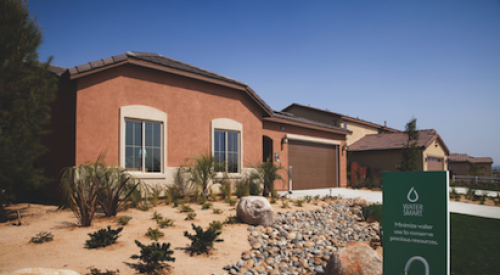|
 David LeBoeuf, left, and Steve Bartholomew, co-owners and CEOs of Main Street Homes. |
That's because entry-level buyers are the key to jump-starting home sales at every price level. They don't have houses to sell. If young renters start buying their first homes again, the huge inventories of unsold new and existing homes will begin to drop and prices of existing homes will stabilize. The lowest level of ownership housing is where the pump must be primed to free the machinery of the entire marketplace.
There's one more reason Bartholomew and LeBoeuf are point men for housing recovery: The Texas markets where they build — Austin, San Antonio and College Station — are not as crippled as those in California, Arizona and Florida. Texas was the last place housing sales stopped. Inventories of unsold homes are nowhere near the staggering levels in California and Florida. And LeBoeuf and Bartholomew say they still see price appreciation in their markets.
“Our average sale is about $133,000, and we don't sell anything for $200,000,” says Steve Bartholomew, “yet houses we sold a few years ago for $160,000 are now selling for $200,000. That's what happens when you build a good house and the value of the location goes up. Our markets are still viable.”
Austin is the state capital, with a government-based economy. San Antonio has a military-centered economy and bases are growing. “There are a lot of young people in Austin and San Antonio who are ready for home ownership,” says David LeBoeuf, “but they are holding back — waiting. They turn on the TV and see the flood of negative national economic news, especially about housing. Naturally, they think this can't be a good time to buy.”
Bartholomew says when Main Street's sales slowed in 2008, he did some research to find out what was happening to the people who were not buying houses. “We learned there's a lot of doubling up going on,” he says. “It won't take much more than confidence to get buyers back into the market.”
What Builders NeedThere is one missing piece to the puzzle, the partners say, and that's where Congress can help. By the time this issue reaches you, it may already be in place because the new Congress is pledged to work at breakneck speed.
“Our buyers need down payment assistance,” says Bartholomew. “When DPA went away last fall, it took a huge segment of first-time buyers out of the market.”
The Main Street partners are convinced their markets will come back faster than others. “What we need is a zero-down FHA loan,” Bartholomew says. “Probably 70 percent of our business is in FHA mortgages. We do some VA business in San Antonio, and there are still a few conventional loans, but the bulk of what we do is FHA. Zero down is the key to this thing. We have prospects who want to buy and can qualify for a mortgage, but they just can't come up with the down payment.”
 David LeBoeuf, co-owner (left to right); Greg Smith, vice president of sales; Steve Bartholomew, co-owner; and Chris Folmar, vice president of operations, at model 1423 in Park Ridge Gardens, Austin, Texas |
Bartholomew and LeBoeuf have evidence to back their contention that first-time home buyers are worthy credit risks. In 2004, they created what they call “The Rainy Day Fund.” Whenever Main Street closes a home, the partners put money into the fund, which is intended to be a safety net if job loss, illness or another calamity jeopardizes home buyers' ability to make the mortgage payment. “We use the fund to help them make mortgage payments until they're back on their feet again,” Bartholomew says. “We've only had to use the Rainy Day Fund five times since its creation. Our delinquency rate is less than the average for all homes. Our buyers have tremendous pride of ownership in their first home.”
Velocity Is VitalThe partners don't deny their business is challenged. “This market is still viable, but it's tough right now,” Bartholomew says, “and our operating model is based on high velocity selling to keep the land turning and make up for the low margin on each house.”
One reason they don't have to compete with national builders is that the margins they operate at don't look appealing, says LeBoeuf. But right now, they are not building enough houses. When the books close on 2008, Main Street will report about 600 closings for last year, compared with more than 1,000 the previous year. Revenues are expected to be down to about $75 million, from $133.1 million in 2007.
Growth EngineBartholomew and LeBoeuf are determined to regain the momentum lost in 2008. All through the 1990s, Main Street grew by 100 closings or more each year until the firm hit a peak of 1,094 closings in 2001, for $124.1 million in revenue. But their home town of Austin, Texas, became an increasingly difficult place to entitle new communities during the 2000s, and Main Street's closings shrank to 562 in 2005 for $70 million in revenue. So Main Street expanded to College Station in 2001 and San Antonio in 2004, and pushed closings back to more than 1,000 a year before the crash of 2008.
 |
“We decided we wanted to be partners in the early 1990s,” Bartholomew recalls, “but we didn't know what business. Then we thought, 'Well, David knows construction, and I know mortgage finance, so let's build some entry houses until something else comes along!' We've never stopped.”
The partners decided their unique selling proposition would be small, well-built homes — with features and attributes associated with larger, more expensive houses. They now have 10 communities in Austin, eight in San Antonio and one in College Station. “We make all the big decisions together,” LeBoeuf says, “I'm more experienced with product, but Steve has developed a very good eye for design.”
Main Street has two product lines, constantly tweaked by an in-house design staff. “The first line is smaller, more basic homes,” LeBoeuf explains. “The second is more feature-oriented, with vaulted ceilings, ceiling fans, and more options and upgrades offered. But we never move walls or make structural changes. Generally, our pricing starts below $100,000 and can go into the $180,000 range if the buyer loads up on options.
“The art of what we do is in the options and upgrades to finishes and materials that we offer. We allow buyers to add their own touch of class to a home,” LeBoeuf says.
They run a lean operation, with only 100 employees to sell, build and close as many as 1,000 homes a year. “Margin control is everything for us,” says Bartholomew. “We're always balancing cost against value perception.”
Expansion PlansThe partners show no interest in other major markets in Texas. “Houston and Dallas are too far away and too big,” Bartholomew says. “We'd have to operate on a scale we're not comfortable with to even be noticed.” But they do have strategic growth plans.
“We've looked at Killeen, which is where one of the largest military bases in the country (Fort Hood) is located,” LeBoeuf says. “The other expansion we may make is into some attached and multifamily product, and we also might try to add some product aimed at active adults and retirees.”
Main Street is developing a new product line to fit on smaller lots. “We've had 30-foot-wide houses that fit on 40-foot lots for years,” Bartholomew notes. “But this year, we want to debut 24-foot-wide houses that fit on 30-foot lots.”
Because of the continuing problems with entitlements in Austin, the partners see their future primarily in San Antonio. “It's a much larger market than Austin,” says LeBoeuf, “but it still represents less than half our total closings, so we have a lot of room to grow there. Land is cheaper. And it's now a very fragmented market.”
Because of the current market shakeout, and the problems of the big public builders, Bartholomew and LeBoeuf believe they have a golden opportunity to grab choice parcels of land and grow market share in San Antonio as housing recovery takes shape.
The only question is: when?
For the answer to that, the Main Street partners are looking to Washington — and crossing fingers.
|











